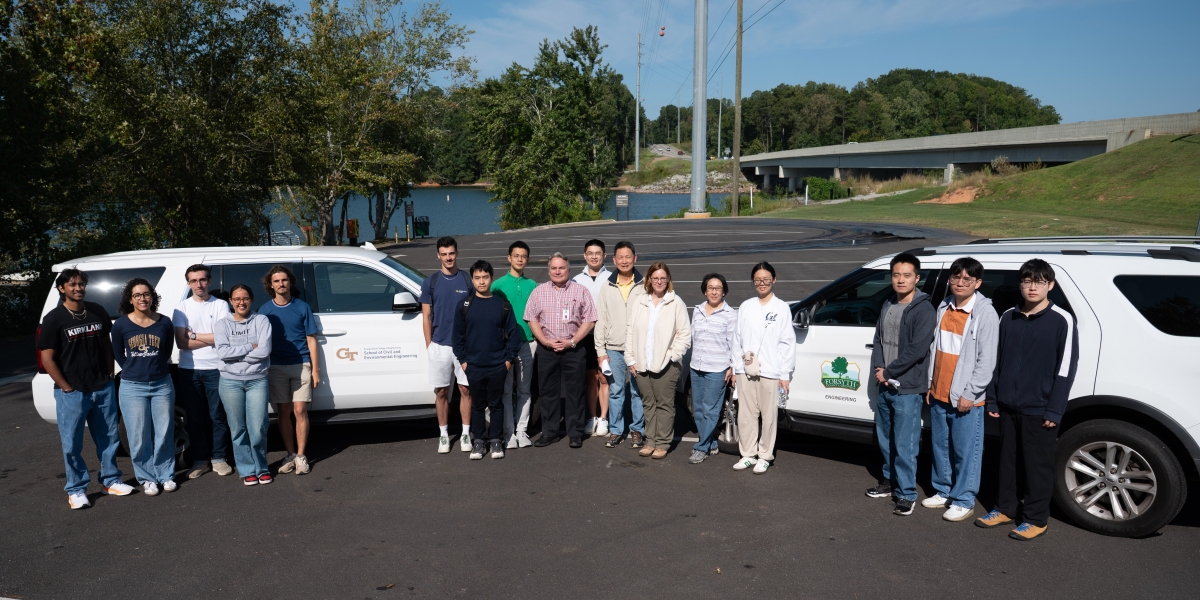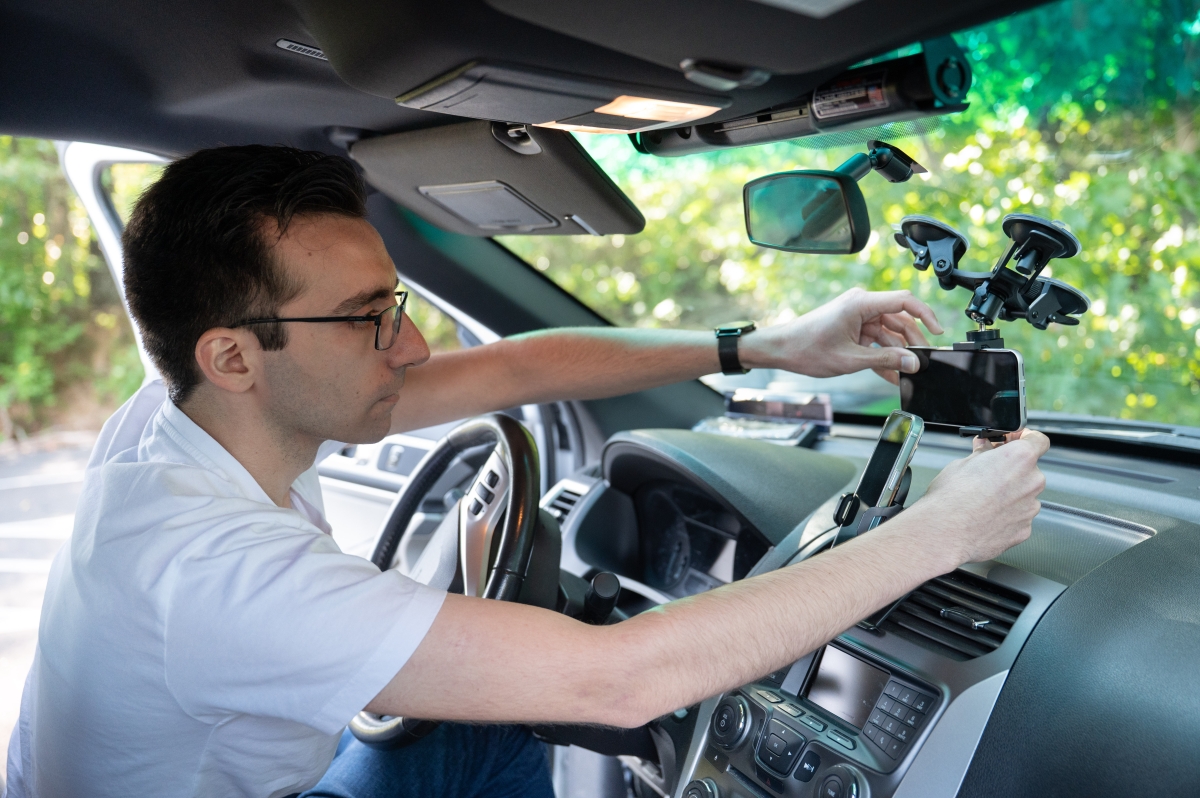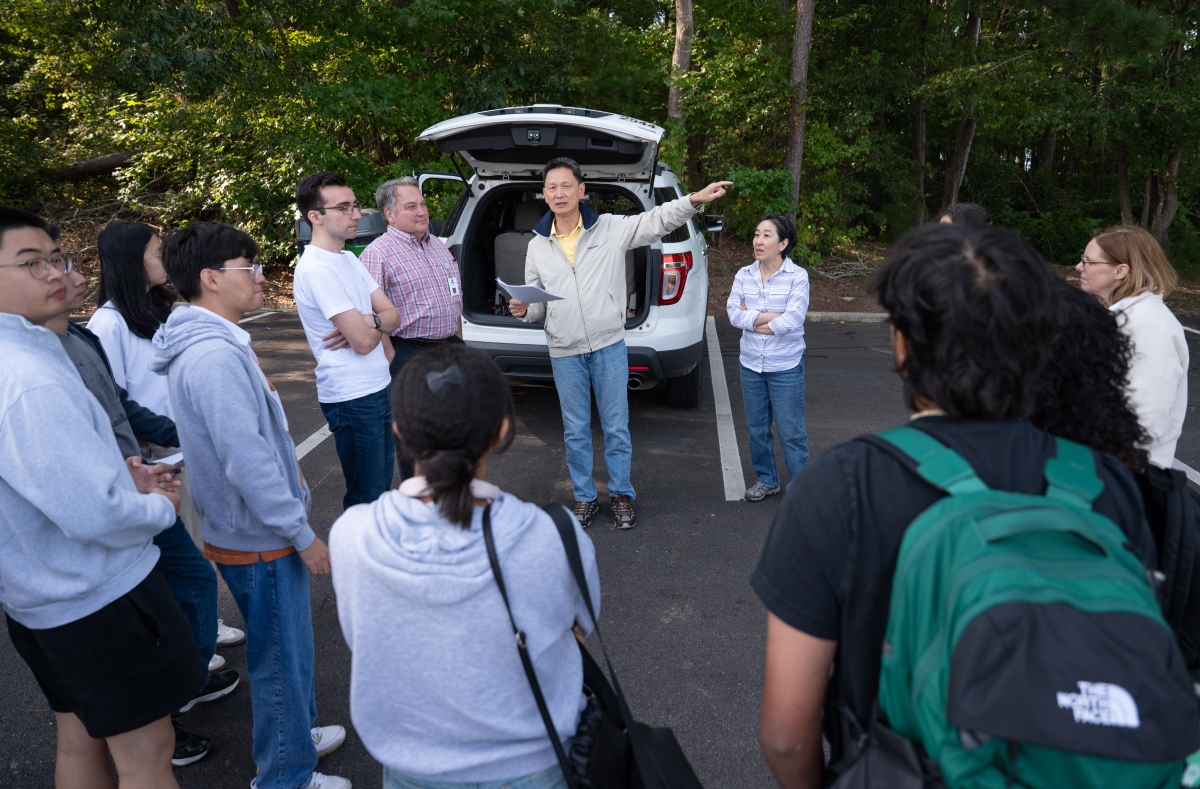
A group of Georgia Tech students joined Professor James Tsai in Forsyth County to demonstrate their technology to Tim Allen and Denise Freund from the Forsyth County Department of Engineering.
When Tim Allen began working for the Forsyth County Engineering Department in 1995, the county had more than 100 miles of rural roadways without posted speed limits and lacking many curve warning signs.
Allen spent months driving the winding roads with a device called a ball bank indicator mounted on the dashboard of his vehicle. Driving up and down the same stretches of roadway, Allen watched the way the ball inside this device moved to calculate safe advisory speeds to drive around curves.
“It took a lot of time and several trips back and forth,” Allen said.
This manual device is still the main method local governments use to determine advisory speeds around curves, which account for 25% of fatal vehicle crashes. And it’s a never-ending effort: Road conditions change over time, making it necessary to check that signage and advisory speed limits are still accurate. However, it’s not feasible for most municipalities to reassess roads frequently due to the time and staffing required.
That’s where Georgia Tech Professor James Tsai and his research team come in.
They’ve developed a way to quickly calculate safe speeds for curves using the sensors built into smartphones.
“Our goal is to develop innovative solutions to address this critical societal challenge and ultimately save lives,” said Tsai, a professor in the School of Civil and Environmental Engineering.
Tsai and his team created an app that collects data from a phone’s camera, accelerometer, and gyroscope while a vehicle is driving around a curve.
Using artificial intelligence, the app calculates a safe driving speed for that stretch of road in real time.
Typically, curves aren’t reassessed until there is an uptick in vehicle accidents. The app allows transportation officials to be proactive rather than reactive and assess roadways more frequently. It also streamlines the process: With the smartphone app, one person can perform an assessment that traditionally required two engineers, reducing the time to reassess a city or county’s roads from years to just weeks or even days.
“With this new technology it would be just as easy to check the entire length of roadway in the time it used to take us to check a single curve,” Allen said.

Ph.D. Student Mohsen Mohammadi mounts a smartphone on the windshield of a Forsyth County vehicle.

Professor James Tsai has spent eight years studying ways to reduce vehicle crashes around curves, which account for 25% of crash fatalities.

Tim Allen, retired assistant director of engineering for Forsyth County, holds the ball bank indicator used to calculate advisory speeds around curves.
In September, Tsai and a team of students drove to Forsyth County to demonstrate the app again to Tim Allen and to Denise Freund, the newly hired deputy director of the Forsyth County Engineering Department, as part of a pilot program to deploy the technology.
The pilot program with Forsyth County is the start of what Tsai hopes will be a solution to better equip local governments for roadway safety management. The goal is to ensure proper curve signage, which can reduce crashes by up to 40%.The collaboration is one of four projects funded last year through the Partnership for Innovation (PIN).
The program supports teams of university researchers and local governments by providing funding, expert advice, and project management on year-long pilot projects across the Southeast.

The app generates a safe advisory speed while driving around a curving road.
As part of their PIN project, the Georgia Tech team was able to put their technology to use on the roads in Forsyth County.
In just an hour, they were able to drive several roads county officials identified as safety concerns and quickly calculate safe speeds.
The app is the culmination of eight years of work and 10 research projects by Tsai and his research group.
Tsai said his students’ passion for safety inspired him to investigate the problem of curve-related fatalities.
In 2023, more than 40,000 people died on U.S. roadways, according to the U.S. Department of Transportation (USDOT). A quarter of these fatal crashes are associated with horizontal curves, the majority of which involve vehicles leaving the roadway and striking trees, utility poles, rocks, or overturning.
“It’s quite serious,” Tsai said. “That’s a national challenge we can take on.”
Tsai started investigating the contributing factors with funding from the Georgia Department of Transportation, National Science Foundation, USDOT, and others.
“Roadway geometry design, speed, site friction of the pavement — there’s a lot of components all combined together causing the problem,” Tsai said.
He studied what signage for safe driving is best and whether applying high-friction treatments to pavement might help. Then he began working with smartphones to create a platform that’s accessible and affordable for local transportation engineers.
Tsai hopes that Forsyth County is just the beginning: he’d like to see the app adopted by other local governments and transportation agencies.

Professor James Tsai, center, speaks to the group before they demonstrate their app on county roads.
“The ultimate goal is to improve roadway safety and save lives,” Tsai said. “Starting from a community like Forsyth, we want to work all the way up and impact the nation and the world.”
